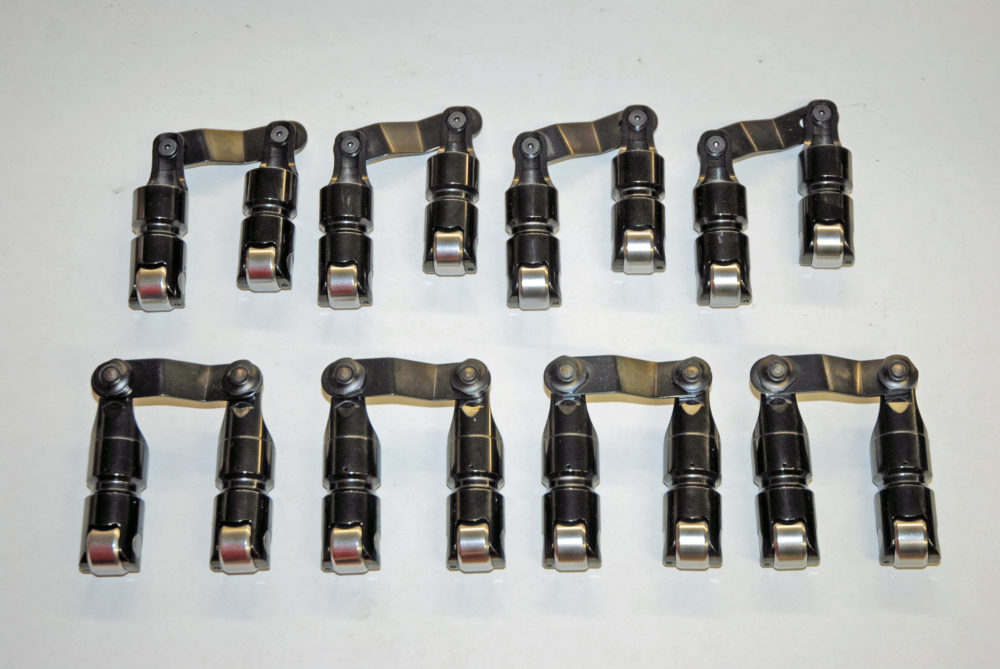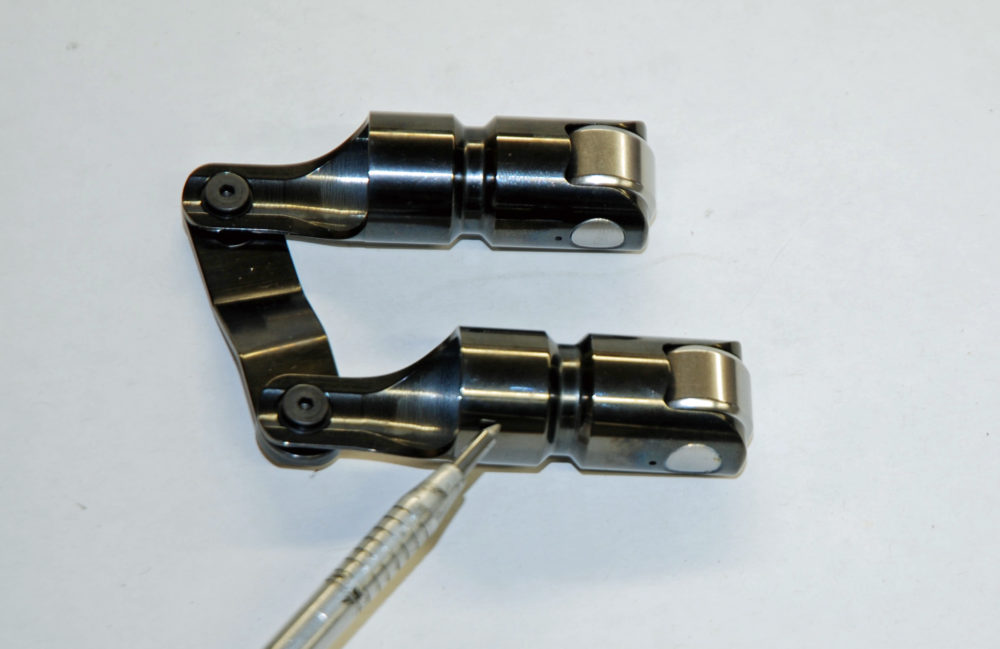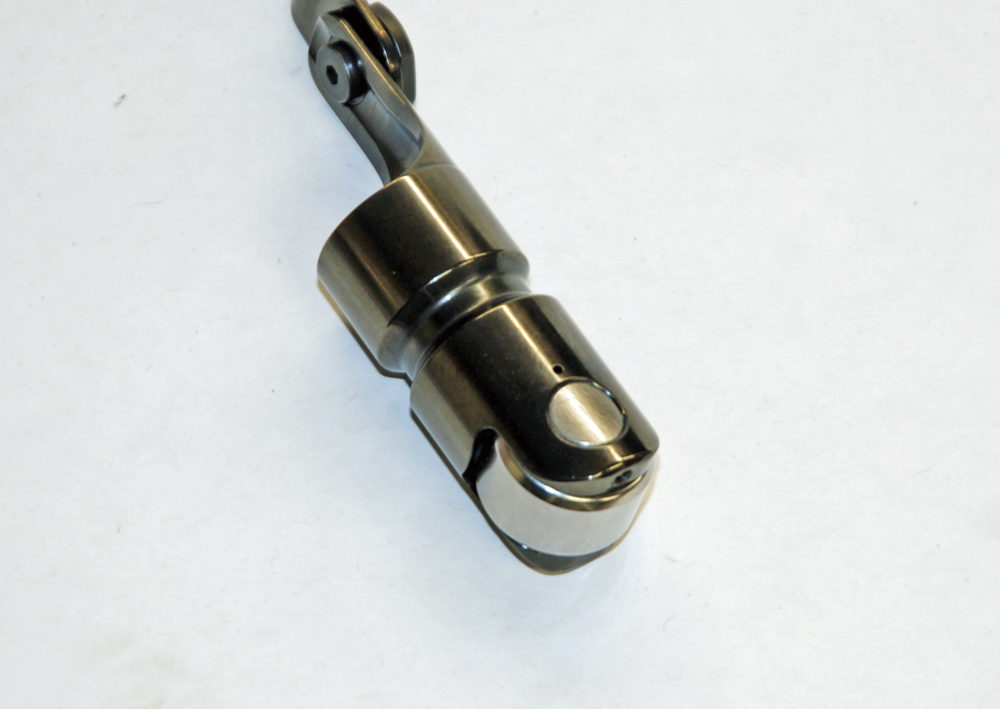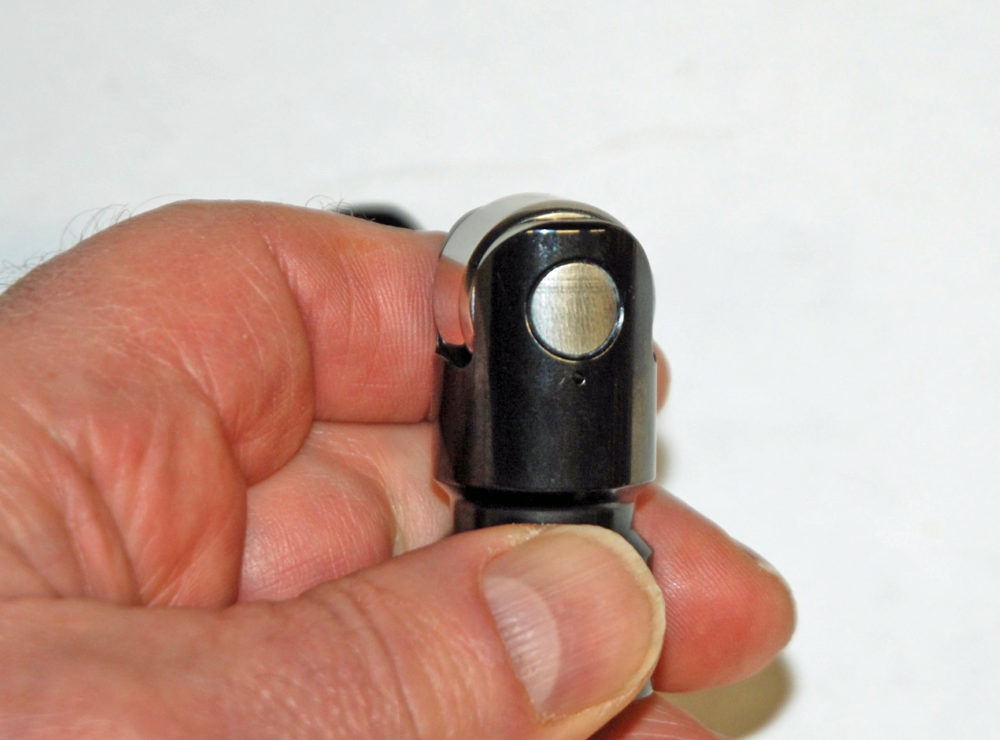
(Image/Wayne Scraba)
There are many roller lifters available today. They range in quality from so-so to over the top. On the over-the-top end of the scale is the lineup from Jesel.
Jesel manufactures a wide cross section of models including some very special lightweight keyed roller lifters that are the darlings of the pro stock/ultra pro street set. To install these, a special bronze lifter bushing (with an index pin groove machined into it) is fitted to the block. In turn, the lifter body incorporates a hardened steel index pin that keeps the lifter from rotating and effectively eliminates the need for a tie bar. These are high-end lifters used where performance means everything and cost is certainly no object.
Right behind them is Jesel’s “Dog Bone” series roller lifter. These lifters maintain alignment by way of a dog bone-shaped steel retainer that bolts to the cylinder block (a simple drill fixture is used to machine the block so that it can accept the lifter).
Next in the Jesel lineup is their tool steel tie bar lifter. They’re lightweight and share many of the features of the keyway roller lifters. Think of them as the keyway lifter with a tie bar instead of a keyway. These are all high-tech lifters and in this day and age, we all know there’s no free lunch—you get what you pay for.
Fair enough, you might say, but what about the little guy? Like a sportsman drag racer or someone who is into fast street-strip cars?
Jesel has that base covered too with their solid body tie bar roller lifters.
Jesel designed this lifter to be a cost effective alternative to their well-proven TS Series lifters (which have won numerous NHRA, NASCAR, PDRA, SCCA and IMSA championships). In order to create these solid body tie-bar lifters Jesel used the same rollers, needles and axles found in their tool steel series lifters, combined with a FEA-designed ultra-smooth REM/ISF® polished DLC-coated, heat-treated body.
Additionally, Jesel holds tolerances far exceeding today’s standards keeping their machined tolerances to 0.0002-inch.
Jesel also lab-tests the alloys coming into the factory to ensure they’re correct. The bottom line is: Jesel takes its quality standards seriously, even with their least-exotic solid body tie bar lifters.

Jesel holds the tolerances to 0.0002-inch (or less) on all lifters, including these little-guy friendly solid body jobs. The actual bodies are precision ground and REM polished and heat-treated.
But wait—what’s with the DLC coating? According to Jesel: “What the Diamond Like Coating does is provide an extremely hard surface on the lifter body which reduces the possibility of abrasive wear.”
The oiling system on all Jesel lifters also contributes to wear reduction. All incorporate an internal oiling circuit that feeds pressurized oil to the needle bearings in the roller. This ensures constant lubrication and eliminates contaminants. A feedhole sprays oil to the outside diameter of the roller which helps prevent cam lobe wear.
Speaking of oiling, Jesel recommends you DO NOT use oil restrictors. You should only use them as a last resort.

Jesel incorporates a full pressure oiling system with all of their lifters. This insures constant lubrication and elimination of any contaminants. Jesel also incorporates a feedhole that sprays oil to the outside diameter of the roller to help prevent cam lobe wear.
“Let the lifters be the restrictors,” Jesel officials say. “With the spring pressures and rocker ratios used in today’s racing engines, the lifters need as much oil to them as they can possibly get. Whenever possible, we suggest plumbing the block so that oil is fed equally to the lifters through the front and rear of the oil galley. In the event that you are getting excessive oil to the top end, provisions should be made for better oil drain back to the pan; either by external scavenging lines or internal drains.”
Jesel’s solid body lifters have a machined pushrod seat directly in the lifter body (no seat to work loose) and also feature a lifter seat that has been dropped down into the lifter body. Why? Simple. By moving the seat down in the body, the pushrod pivot point is moved closer to the roller axle which means there is less leverage to rock the lifter in the bore.

The pushrod seat isn’t a common drop in job held in place by a circlip of some sort. Instead it’s machined directly into the body of the lifter. There’s nothing to fall out or break.
“Think of it this way, if you’re trying to tip something over, the higher you push, the easier it gets,” Jesel officials say.
The actual lifter wheel rolls on bearings.
But aren’t bushings the hot setup?, you might ask. That’s a modern racing myth.
Jesel has spent a lot of time and money investigating the roller wheel, bearing types, and the axle. Bushings tend to increase friction and can, in some instances, put added wear on the cam. The reality is, in the vast majority of applications where the speeds and loads on the roller tend to be extremely high, Jesel officials say the needle-bearing roller is a must.
According to Jesel: “Unlike a rod or main bearing, there is not enough oil pressure available to a lifter roller to sustain an oil film needed between an axle and bushing to keep it from galling or wearing.”
When designing the axle for all of their lifters, Jesel came up with an internal locking pin that secures the axle to the body. This configuration eliminates the possibility of severe engine carnage caused by external snap rings and Spiro-Locs coming loose.

Roller axles in the Jesel lifters are held in place by way of an internal locking pin. This way, there are no c-clips or other snap rings to work their way loose. While you can see it, the wheels turn on roller bearings (no bushings are used).
When it comes to the size of the roller, bigger is better. When the diameter is increased, the roller becomes stronger. This is due to an increased cross-sectional area between the I.D. and the O.D. of the roller. Additionally, a larger-diameter roller rotates more slowly and reduces the loads needed to open the valve train. It may be necessary to rethink the cam specs when using a larger-diameter roller due to an increase in duration. Jesel notes that a larger-diameter roller may allow you to get more aggressive with your opening ramp design.
Keep in mind that as the lifter body diameter is increased, the diameter of the roller can be increased as well. Jesel lifter sets are available in 0.842-inch, 0.875-inch, 0.905-inch and 0.937-inch diameters for most popular OEM and aftermarket racing engines. Lifters with a 0.842-inch and a 0.875-inch diameter make use of a 0.760-inch diameter roller with a 0.405-inch needle bearing length. The larger 0.905-inch diameter lifters have a 0.820-inch diameter roller, and the 0.937-inch diameter lifters have a larger 0.850-inch diameter roller. Both use a 0.450-inch needle bearing length.
These lifters are available in a variety of pushrod offsets for various engine combinations. This is particularly important if you have something like a spread port head combination.
In the end, you really do get what you pay for. And with these Jesel lifters we’ve found professional grade technology and quality, even in their sportsman applications.
They really are over the top.

Comments